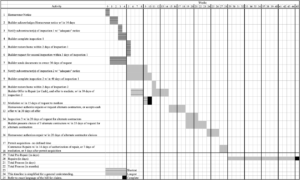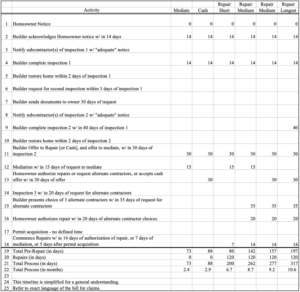Introduction
Senate Bill (SB) 800, the ‘Builders Right To Repair’ bill was signed into law September 20, 2002, and took effect for every living unit sold in California after January 1, 2003. Printed the bill is 12 pages and specifies the rights and requirements of a homeowner to bring a construction defect action, contains building standards and functionality requirements for new residential units, and gives a detailed pre-litigation procedure. SB 800 was developed as a compromise of various factions of the building and legal communities to address the problems of the home building industry. The 9,000 word bill states the intent of the legislature is to improve the procedure for the administration of civil justice in construction defect cases.
Problems that led to the development and passage of the bill into law include:
-
Issues of quality in home building and consumer protection
-
Pervasive construction defect litigation
-
A lack of insurance coverage for builders, subcontractors, and suppliers
Important components of SB 800:
-
Pre-litigation procedure requires the owner to notify and allows ‘Builders Right To
Repair’ before being sued
-
Immunity for ‘qualified’ third party quality inspectors. This is meant to encourage the
practice of third-party quality control.
-
Allows recovery for damages previously excluded under Aas
-
Builders must notify owners of maintenance requirements and SB 800 protections at
time of sale
-
Builders now have a document retention requirement, by statute
-
Specific statute of limitations, less than the blanket 10 years, for many components in
residential construction
-
Builders cannot demand a ‘release’ for performing repairs. Builders can get a full
release if they offer cash or upgrades in return for release.
-
The pre-litigation process does toll the statute of limitations
-
Conduct during the pre-litigation procedure is admissible in a subsequent suit. Bill does
apply to subcontractors, suppliers, manufacturers and designers, except pre-litigation procedure
Actionable Defects
Water Issues
(1) A door shall not allow unintended water to pass beyond moisture barriers.
(2) Windows, patio doors, deck doors, and their systems shall not allow water to pass beyond moisture barriers.
(3) Windows, patio doors, deck doors, and their systems shall not allow excessive condensation.
(4) Roofs, roofing systems, chimney caps, and ventilation components shall not allow water beyond moisture barriers.
(5) Decks, deck systems, balconies, balcony systems, exterior stairs, and stair systems shall not allow water to pass into the adjacent structure.
(6) Decks, deck systems, balconies, balcony systems, exterior stairs, and stair systems shall not allow unintended water to pass within the systems themselves and cause damage.
(7) Foundations and slabs shall not allow water or vapor to enter into the structure so as to cause damage.
(8) Foundations and slabs shall not allow water or vapor to enter into the structure so as to limit the installation of the type of flooring materials.
(9) Hardscape, irrigation systems, landscaping systems, and drainage systems, shall not cause water or soil erosion or come in contact with the structure so as to cause damage to another building component.
(10) Stucco, siding, exterior walls, exterior framing, exterior wall finishes and fixtures, pot shelves, horizontal surfaces, columns, and plant-ons, shall be installed in such a way so as not to allow unintended water to pass into the structure or beyond moisture barriers.
(11) Stucco, siding, and exterior walls shall not allow excessive condensation to cause damage to another component.
(12) Retaining and site walls and their drainage systems shall not allow unintended water to pass beyond moisture barriers so as to cause damage.
(13) Retaining walls and site walls, and their drainage systems, shall only allow water to flow beyond, around, or through the areas designated by design.
(14) The plumbing system, sewer system, and utility systems shall not leak.
(15) Plumbing, sewer, and utility lines shall not corrode so as to impede the useful life of the systems.
(16) Sewer systems shall allow the designated amount of sewage to flow through the system. (17) Shower and bath enclosures shall not leak water into the interior of walls, flooring systems, or the interior of other components.
(18) Ceramic tile and tile countertops shall not allow water into the interior of walls, flooring systems, or other components so as to cause damage.
Structural Issues
(1) Foundations shall not contain significant cracks or vertical displacement.
(2) Foundations shall not cause the structure to be structurally unsafe.
(3) Foundations and soils shall comply with the design criteria for chemical deterioration or corrosion resistance in effect at the time of construction.
(4) A structure shall comply with the design criteria for earthquake and wind load resistance.
Soil Issues
(1) Soils and retaining walls shall not cause damage to the structure.
(2) Soils and retaining walls shall not cause the structure to be unsafe.
(3) Soils shall not cause the land upon which no structure is built to become unusable.
Fire Protection
(1) A structure shall comply with the design criteria and codes.
(2) Fireplaces, chimneys, chimney structures, and chimney termination caps shall not cause unreasonable risk of fire.
(3) Electrical and mechanical systems shall not cause unreasonable risk of fire.
Plumbing and Sewer Issues
Plumbing and sewer systems shall operate properly and not impair use of the structure. Four year statute.
Electrical System Issues
Electrical systems shall operate properly and not impair the use of the structure. Four-year statute.
Other Areas of Construction
(1) Exterior hardscape (driveways, sidewalls, etc.) shall not have excessive cracks or vertical displacement. Four-year statute.
(2) Stucco, siding, and exterior wall finishes shall not contain significant cracks or separations. (3) (A) To the extent not otherwise covered by these standards, manufactured products, shall be installed so as not to interfere with the products’ useful life.
(3) (B) “useful life” means a representation of how long a product is warranted or represented, through its limited warranty or any written representations, to last by its manufacturer, including recommended or required maintenance. If there is no representation by a manufacturer, a builder shall install manufactured products so as not to interfere with the product’s utility.
(3) (C) “manufactured product” is completely manufactured offsite.
(3) (D) If no useful life representation is made, the period shall be no less than one year. This subparagraph does not limit recovery if there has been damage to another building component caused by a manufactured product during the manufactured product’s useful life.
(3) (E) This title does not apply in any action seeking recovery solely for a defect in a manufactured product located within or adjacent to a structure.
(4) Heating, shall be capable of maintaining a temperature of 70 degrees Fahrenheit three feet above the floor in any living space.
(5) Air-conditioning, shall be consistent with the size and efficiency design criteria in Title 24 of the California Code of Regulations.
(6) Attached structures shall comply with interunit noise transmission standards. One-year statute.
(7) Irrigation and drainage shall operate properly. One-year statute.
(8) Wood posts shall not be installed so as to cause decay. Two year statute.
(9) Steel fences shall be installed so as to prevent corrosion. Four year statute.
(10) Paint and stains shall be applied so as not to cause deterioration of the building. Five year statute.
(11) Roofing materials shall be installed so as to avoid materials falling from the roof.
(12) Landscaping shall be installed so as to survive for not less than one year. Two year statute.
(13) Ceramic tile and backing shall be installed so it does not detach.
(14) Dryer ducts shall be installed pursuant to manufacturer requirements. Two year statute. (15) Structures shall be constructed so as not to impair the occupants’ safety.
The standards set forth in this chapter are intended to address every function or component of a structure. To the extent that a function or component of a structure is not addressed by these standards, it shall be actionable if it causes damage.
‘Builders Right to Repair’ Calendar

‘Builders Right to Repair’ Calendar

